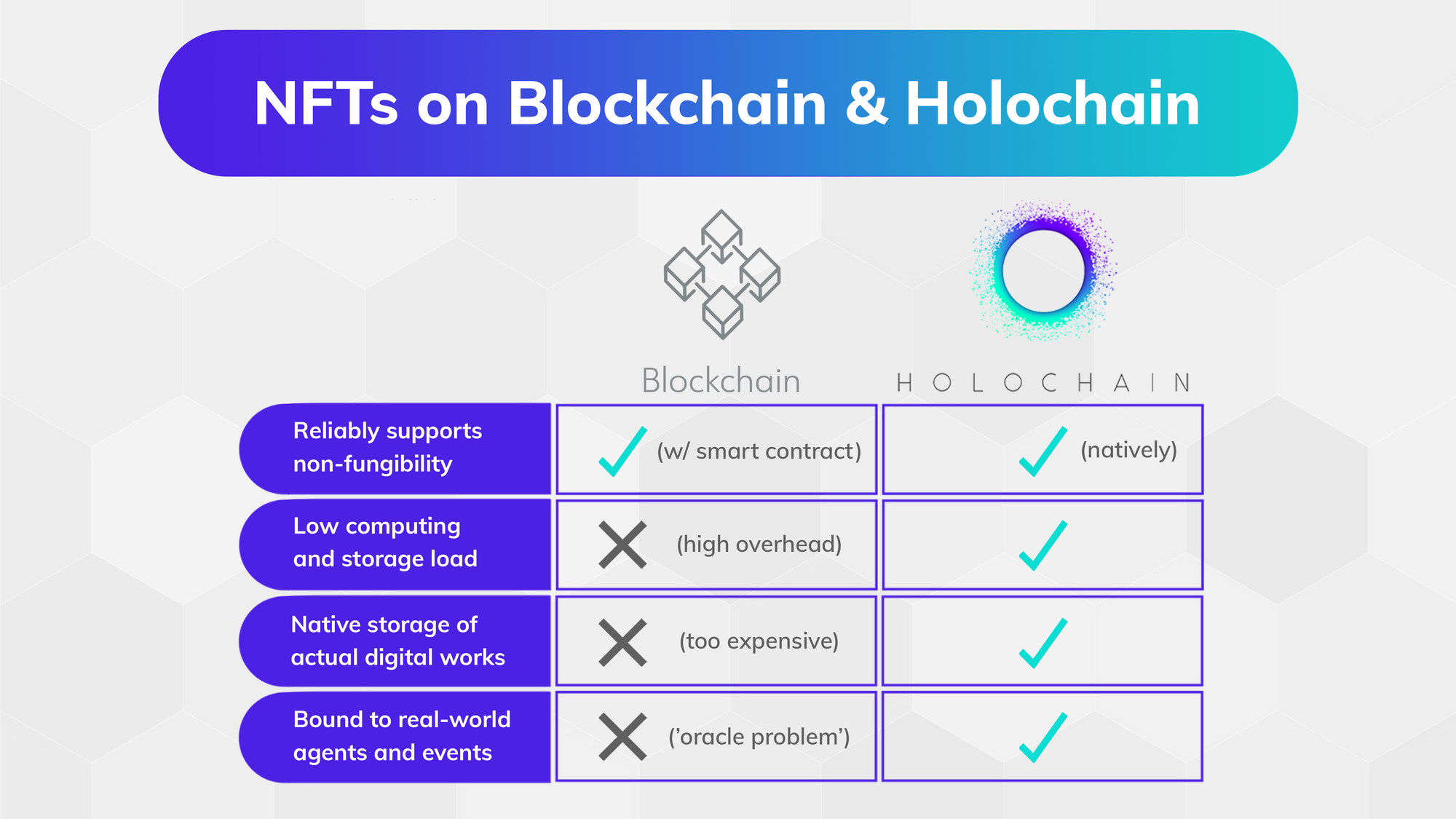Are non-fungible tokens the biggest thing in crypto ever? Apparently, they are bigger than DeFi, Hip Hop, and Hollywood. We’ll see. But the prospect of immutably tracking ownership of things without centralized intermediaries certainly has people’s attention. And, in many cases, their money: the first half of 2021 saw close to $2.5B in NFT sales, with some tokens going for millions apiece.
I won’t try to make this article an NFT explainer, but the basic idea is that NFTs are meant to be unique representations of ownership of an object. Objects can be digital, like a particular tweet or image file, or, in principle, physical, like a house.
To date, NFTs have been versions of smart contracts, meaning they are programs that execute particular functions using a blockchain-based computing network such as Ethereum’s. For example, an NFT might have not only a means of its ownership being transferred (with that record then stored on the blockchain), but also of a royalty being automatically sent back to the original artist every time that happens (with payment sent automatically by the blockchain network).
So, it might seem that NFTs rely on blockchain technology. It turns out, though, that NFTs are more straightforward, more versatile, and more efficient to run on Holochain than on blockchain. In this article we look at three ways this is true and why. But first a word on what it means for something to be ‘fungible’.

On Fungibility
When an item is fungible, it’s interchangeable with other instances of the item:
- A can of soup is more-or-less interchangeable with other cans produced from the same batch.
- A brand-new tennis racket is more-or-less interchangeable with other brand-new rackets of the same make and model.
- Units of a currency are designed to be interchangeable with all other units of that currency.
Items in real-world systems, meanwhile, are rarely fungible:
- An acre of land isn’t interchangeable with other acres of land. This is why we have title records that rely on wordy descriptions of property, containing latitudes, longitudes, landmarks, and other surveyor notes.
- Your favorite houseplant isn’t interchangeable with similar plants.
- Friends are not interchangeable, despite what our Facebook counts might imply.
Actions are also not interchangeable:
- When someone says “I love you”, it’s not equivalent to when someone else says it, or even when the same person says it at a different place and time. The meaning and value of the statement is inherently connected to the context in which it was spoken.
- When someone dunks a basketball, it’s a unique dunk at a unique moment in time. The two points are equivalent to all the other points scored in the game, but the play has more nuance and more value than just the points scored: it provides momentum, it makes highlight reels, and it might build fan excitement or star power in a particular way that a different dunk in a different moment does not.
And, of course, physical artworks and acts of art are not fungible: paintings, hand-made sculptures, particular performances of a piece of music.
What about a digital work? This one is a little trickier, because digital works can be easily replicated. But the movement toward NFTs is predicated on an idea that someone can declare a digital work to be scarce– “there will only be one NFT representing this basketball highlight clip” or “I will sell only 50 NFTs representing this painting” – and then the item, or at least its representation(s), are made scarce by that act. The token(s) representing the digital work are non-fungible.
Alright, with that established, here are three reasons NFTs make a lot of sense on Holochain.

I. Holochain NFTs are Efficient
Because blockchains are historically designed to manage interchangeable units of currency, there’s no inherent function to make units unique. When Alice spends 10 Bitcoin from her wallet, there’s no way of identifying whether the units she’s spending are ones she got from Bob, Carol, or elsewhere. It’s like water scooped into a bucket: when you scoop some out, you don’t know which inbound scoop of water the molecules you’re getting came from.
So in order to create a unique representation of something, an additional layer must be created: smart contracts that uniquely identify assets and keep the NFTs distinct from one another as their ownership is transferred. The idea is to make sure that a particular token isn’t just a representation of a certain piece of art; it is the token representation of the piece of art.
Holochain is different in its principle of provenance: every piece of data, everything ever said or done, is associated with its source. This means that every piece of data, including every token, is inherently unique – the data itself plus its source information – so no additional code is required to keep instances of data distinct from one another. Thus, an NFT on Holochain is an extraordinarily simple application: it’s just a transfer protocol, a means of assigning the token from one person to another.
Holochain’s built-in uniqueness saves on all kinds of work and costs relative to blockchain-based NFTs – developer work, storage work, and especially computing work, all of which lead to energy consumption and cost. We wrote previously about how blockchain’s need to reach global consensus results in substantial costs (usually called gas fees), transaction delays, ecological impact, and other inefficiency challenges. With NFTs this is even more the case, since blockchain NFTs are particularly energy-intensive relative to ordinary transacting. Plus, as with all blockchain smart contracts, nodes are required to retain all transaction data forever, so there’s a hefty storage cost in addition to computing cost. And that’s to say nothing of storing the actual digital works that NFTs often represent.
II. Holochain NFTs Can Store the Actual Digital Work
Blockchain-based NFTs are not the actual file they represent, nor do they contain the actual file they represent. The digital work needs to be stored somewhere else – somewhere public – in order for it to be clear what the token represents. But how meaningful is it, really, to own a token of something that anyone else can access and download for themselves any time?
It’s no wonder that people question the point of NFTs and debate whether an item that’s not actually scarce can just be declared to be scarce and sold as such. Sure, there’s a case for saying the answer is yes – after all, that’s sort of what money is – but wouldn’t it be better if it were possible to buy and sell the actual unique digital file along with the NFT? Then there’s just no question.
Holochain makes that possible because files can be stored privately on one’s own personal ledger of events known as a source chain. The record representing the file’s ownership is made visible to the network, along with maybe a thumbnail of the image, but the file itself does not need to be published, even as the two are inextricably linked. This way, an artist can create a digital asset that is truly unique (or limited to a certain number of ‘prints’). When an NFT is signed over to a new owner, the actual file can get sent along with it, without sharing a copy with the world, similar to transferring a physical art piece.
It’s also easy to create ‘replicas’ of the digital work – versions that can be published widely that differ just a bit, visibly or invisibly, from the original(s). This way, the work can still serve a public purpose and/or become widely known, even as the ‘real’ version, which might be the highest-resolution version, lives safely with its owner… again, just like in the physical art world.
III. Holochain NFTs Can Represent Real-World Works and Property
How do we know for sure that a blockchain-based NFT represents the work it claims to represent? For digital works the mechanism is reasonably reliable: a unique ‘hash’, or fingerprint, of the digital file is created and stored as part of the token. But for non-digital works, the mechanism breaks down. There’s no way to be sure that the NFT you’re buying is the NFT that corresponds to the piece of land, the boat, or the painting in question. It’s a version of blockchain’s oracle problem: with everyone being anonymous and no central authority, it’s virtually impossible to incorporate real-world events (such as the creation of a painting) into on-chain events (such as designating a token to uniquely represent the painting). For this reason, blockchain-based NFTs have so far focused on digital works only – quite a major limitation.
Whereas blockchains try to provide anonymity, Holochain is optimized for accountability. Holochain’s provenance means that it’s always evident who created the NFT; its creation is digitally signed by the creator’s private keys. If an NFT supposedly represents The Starry Night, you can check to see if it was created by Vincent Van Gogh, or (more likely) the Museum of Modern Art. Of course you might have some real-world homework to make sure that the MOMA was the rightful owner of the painting at the time of the NFT’s creation, but records already exist for that, and in any case it’s a much smaller problem than one in which anyone can anonymously create an NFT claiming to represent the painting.
(Yes, you’d also need a reliable way of knowing that the private key account claiming to be the museum is actually the museum, but this is easily accomplished through Holochain’s identity protocols.)
If someone else is trying to sell you The Starry Night, you can readily see the chain of ownership within the NFT’s published records, all the way back to the MOMA if this is the legitimate NFT. So not only are you sure that this NFT truly represents the painting, but you’re also sure that the person claiming to have the current right to sell it truly does.
The Future of Ownership
With the ability to represent real-world objects, the implications of Holochain NFTs extend well beyond artworks to all kinds of property – land, homes, and vehicles, for starters – pointing to a future of ownership that is digital, reliable, and independent of centralized government records.
Right now, every time you buy a house, or even refinance one that’s already yours, you pay thousands of dollars for agents to search a patchwork of municipal records systems, to make sure that the property description (still) accurately describes the property and that the title is free and clear. Title insurers currently collect $16B annually in the U.S alone, mainly to ensure that property owners have the rights to sell the property they’re selling (and insure against the possibility that they don’t).
None of that is necessary in the Holochain age. Each piece of property can simply be referenced by a digital identifier, which could be called a token, that is created by the property’s originator and passed through immutable transfer protocols when a sale is made. Like all data on Holochain, the NFT data is hosted by the owner of the property. (Or on a peer hosting network such as Holo – but still affiliated with the property owner’s private signing keys.) The data is then ‘published’ (shared) to a table that is also held among the members of the network.
Government clerks could still sign every property transfer; we’re not talking here about eliminating municipal systems necessarily, or at least not eliminating them prematurely. But the government no longer needs to manage and host a whole bunch of offline or online infrastructure, and people retain authoritative copies of their own records.
Permissions can also be set so that owner information is shared only on a need-to-know basis, which could be useful in particular for vehicles, where we expect more privacy than with property ownership.
There’s precedent for this kind of scenario already. Estonia has converted its property records to being hosted on immutable hash chains. But Estonia did need to build new infrastructure to pull this off, plus the records are still relatively centralized, with government agencies remaining a point of enclosure (concentrated power) as well as still incurring overhead that needs to be paid for one way or another.
When everyone can just speak for themselves about their right to sell their property, with their speaking instantly verifiable just by looking at the record they’re presenting, the tracking of ownership becomes quite simple. So does shipping and logistics, which isn’t chain-of-ownership but is still chain-of-custody: imagine simplified tracking of who delivered what to whom when, making REA accounting easy (HoloREA is building such tools [short video|full video|Github]) as well as improving supply-chain transparency so you can tell where your food, electronics, and other products came from.
More broadly, provenance around custody is a version of provenance around information: we wrote previously about the idea of a Holochain-powered verified web, in which signal (accurate information) is discernible from noise (potential disinformation) because no one can ever claim something was said that wasn’t, or claim something wasn’t said that was.
It might seem like a stretch to categorize provenance of all information on Holochain, property-related or otherwise, as a version of ‘NFTs’. But, from a technical standpoint, it’s actually not. Every communication and transaction on Holochain, whether it’s sending money, transferring property rights, or ordering a sandwich, is inherently non-fungible because data is always associated with stamps of time and authorship. This makes every entry of data, effectively, a unique token. Thus, Holochain isn’t just an ideal framework for NFTs; it builds the properties everyone wants from NFTs into everything. From a Holochain vantage point in which all data is already unique, the very idea of making data unique, which is what blockchain NFTs jump through hoops to try to do, may begin to seem like an artifact.



